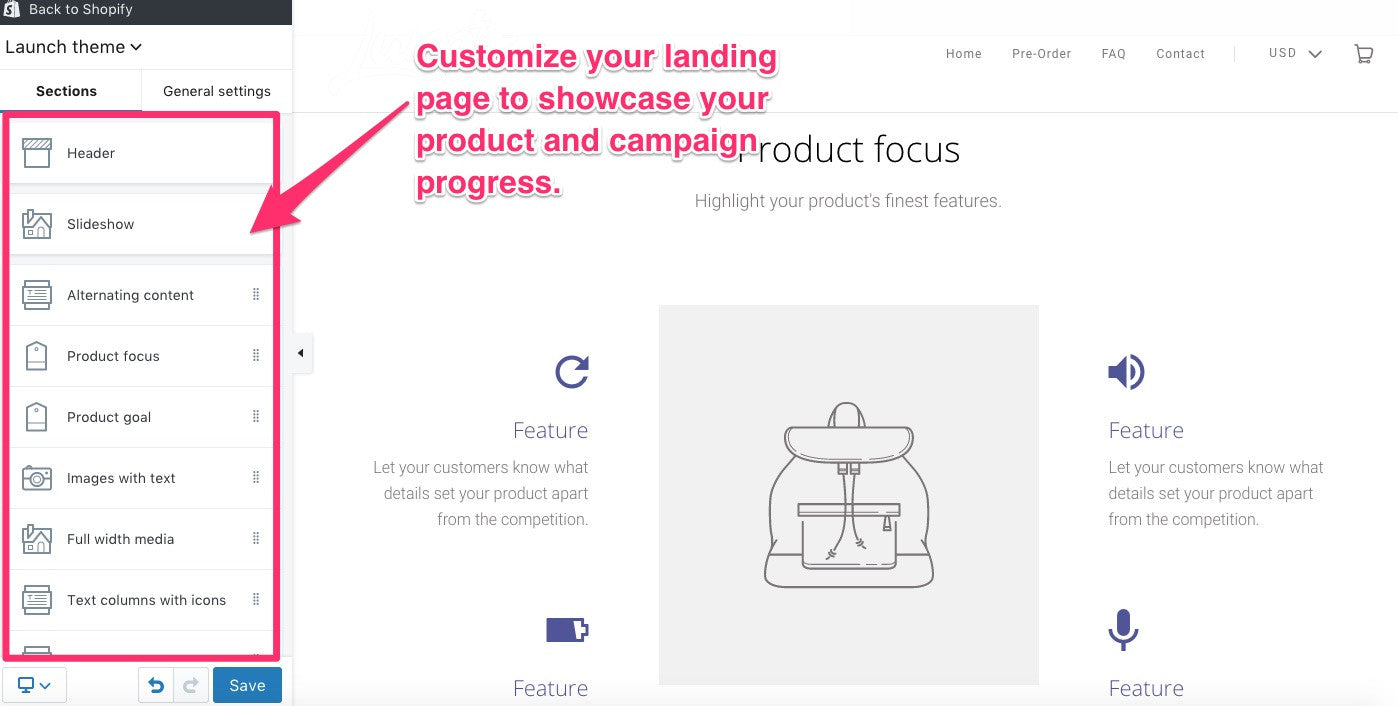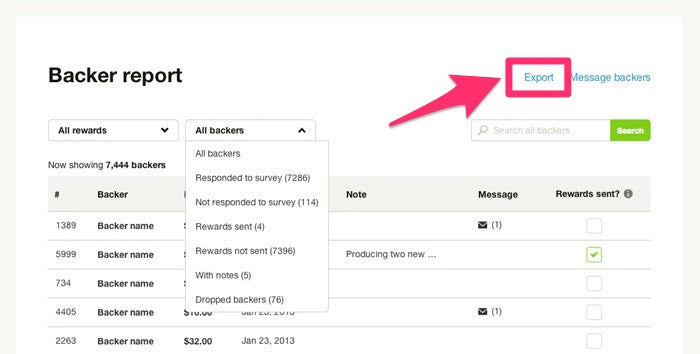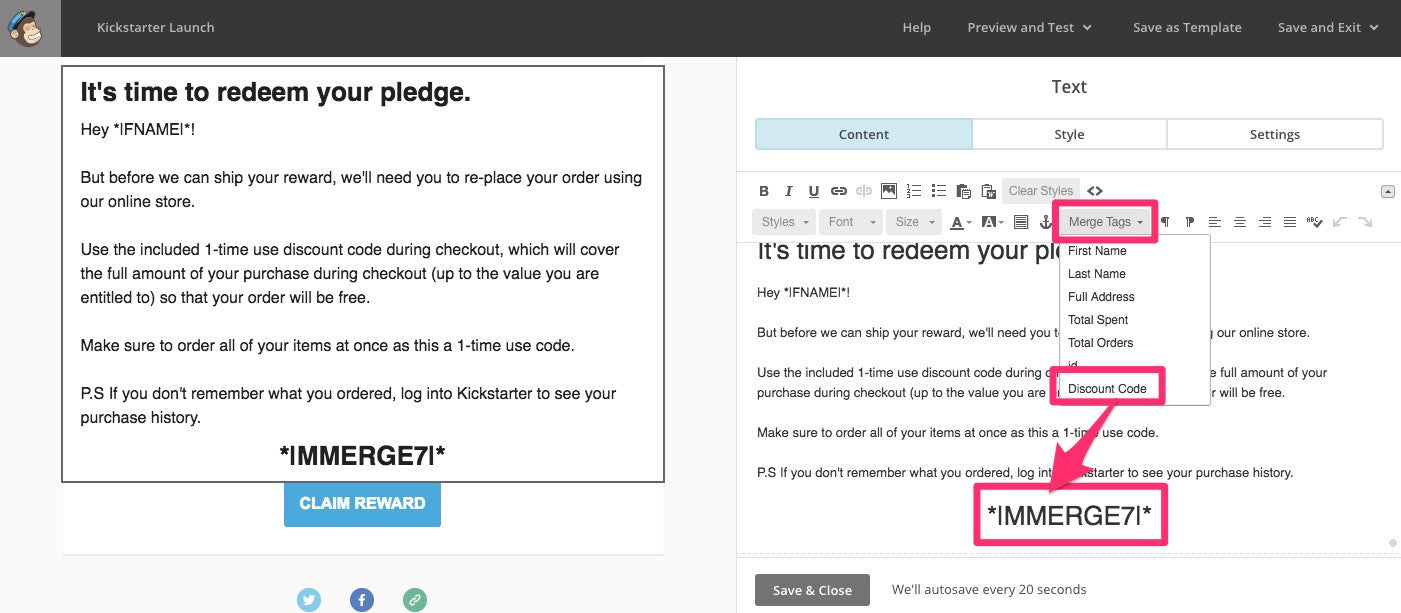How to Transition From a Kickstarter Campaign to a Successful Shopify Store
Kickstarter is great for raising the funds you need to turn product ideas into actual products.
But often the next step, after you’ve completed a successful campaign, is to turn those products into a long-term business.
From Rockwell Razors to Smart Nora, plenty of successful crowdfunding campaigns have grown into wildly successful ecommerce businesses thanks to Kickstarter and Shopify.
Whether you’re in the early stages of your campaign, or have just met your funding goal thanks to all your hustling and the support of your backers, you need to start thinking about how you’re going to deliver on your promise and what comes next.
But transitioning from Kickstarter to an online store can be a complicated process.
That's why we've put together this guide to help you every step of the way.
Why You Should Start Your Ecommerce Store Before You Launch
Running a successful Kickstarter campaign is already a lot of work. So why would you want to add more to your load?
The short answer is it will actually save you from a lot of headaches down the line and make it easier in the long run as you transition from a successful Kickstarter campaign into a full-fledged ecommerce business.
The long answer is that having an ecommerce infrastructure early on will enable you to:
- Start building your email list and accelerate your email collection efforts.
- Use email marketing to communicate with customers, opening up opportunities to upsell, deliver newsletters, and more.
- Retarget visitors with ads to convert them into backers and customers (you need an website or landing page outside of Kickstarter to use Facebook’s conversion tracking pixel).
- Manage orders in a central place: Having all your orders in one place and moving away from backer reports/spreadsheets helps you avoid making mistakes, duplications, and delays, and streamline fulfillment now and for the future.
- Integrate print-on-demand services to offer simple rewards like t-shirts, swag, accessories, and more without any upfront costs.
- Understand your most valuable backers/customers based on purchase history lifetime value.
- Run referral and loyalty programs to increase your repeat purchase rate and potential to acquire new customers.
- A/B test copy and design choices: With a store, you can actually begin to test anything from different messaging to colors to optimize your landing page over time.
As you make the move to your online store, this guide will cover everything from setting up your Shopify store, migrating your backer data from Kickstarter, fulfilling rewards, and planning for growth.
If you already have an existing Shopify store, consider using a solution like Backer Kit under the following circumstances:
- Assigning a retail value to rewards would be too complicated because you have multiple variants for your products (colors, sizes, etc.) AND you offered your products at different discounted prices for each backer level.
- You don’t want to confuse your existing online customers with Kickstarter pre-order items on your store that aren’t available to everyone yet.
“BackerKit is an invaluable tool for Rockwell Razors while we run crowdfunding campaigns or pre-orders for innovative new products that aren't available for shipping quite yet, while simultaneously continuing regular operations on our Shopify store of regular-stock products.” — Rockwell Razors
Pre-Launch: Setting Up Your Ecommerce Business
Whether you do it before your product launches or after, you’ll inevitably need a place for your business to live.
As a bare minimum you should consider setting up a separate landing page to complement your Kickstarter campaign, which you can easily build and launch on Shopify.
Once you’ve signed up, it’s time to build your landing page and create the infrastructure you need for an effective ecommerce machine.
Choose a theme
One of the first things you’ll need to do when you set up your store is choose a theme, which you do by heading over to the Theme Store or visiting Online Store > Themes in the admin.
There are over 100 styles to choose from in the theme store, but the following themes have been popular choices among past Kickstarter successes:

Whatever theme you choose, check to make sure it has the features you need, such as a Funding Goal Tracker, an “As Seen On” section, Customer Testimonials, Press Quotes, or Email Signup.
You can also add more features as you need them through free and paid apps at any time via the Shopify App Store (more on that later).
Customize Your Theme and Build a Landing Page
Once you’ve chosen your theme, it’s time to start building your landing page by clicking on the Customize Theme button in Online Store > Themes. You can edit, add, and remove sections to build a landing page that suits your needs.

Consider the following landing page design best practices and resources as you go about building this page:
- Write customer-focused copy: Use a compelling, benefit-driven headline and cater to your target customer’s needs with the language of your copy, appealing to pain points and leveraging compelling numbers.
- Highlight social proof: Feature testimonials, quotes, influencers, articles in the press, and any proof you’ve amassed that shows visitors that you’ve already been validated by others.
- Collect emails: Give visitors a way to opt in for updates so you can start sending out email marketing campaigns.
- Showcase your product photos: Good looking imagery is key to create demand for your products when prospective customers see them. Show your product off at different angles and how it looks in action.
- Display your campaign progress: Showcase your Kickstarter goal and update your progress regularly over time.
- Add pre-order buttons: Have one or two buttons on the page that feature a call to action (e.g. “Pre-Order Now”) that directs visitors to your Kickstarter page. Be sure to use UTM parameters in your link so you can track traffic coming from your Shopify store (e.g. “www.kickstarter.com/projects/yourbrand/yourcampaign?utm_source=shopifystore”).
Install Google Analytics and Your Facebook Pixel
After you’ve created a working landing page (something you can test and optimize over time), you should set up Google Analytics so you can have a better understanding of where traffic is coming from and how it’s behaving on your site.
You can also set up your Facebook Pixel so you can begin to track visitors to your site from Facebook ads, retargeting them during your campaign and after you launch.
![]()
It only takes a few minutes, but if you’re unsure where to start, check out our guide to Google Analytics and setting up your Facebook pixel.
Select Your Email Marketing Solution
Introducing email marketing early on gives you control over a direct communication channel you can regularly use over the course of your Kickstarter campaign and beyond it.
You can use email marketing to build hype, ask backers to share your campaign with their networks, and reach your backers when you’re ready to launch.
Building an email list should be a priority for any business since, unlike paid advertising channels, you don’t need to pay to reach these people each and every time you want to.
But when running a Kickstarter campaign, it’s doubly important to start early so you can start growing your list before you officially launch.
MailChimp (free up to 2000 contacts) and Klaviyo (free up to 250 contacts, but with some great ecommerce-specific features) are two popular options you can start with.
Both of these platforms integrate with Shopify in seconds, and you will need to choose one in order to follow this process.
Set Up Your Domain
If you’re going to be selling online, you’re going to need to buy some real estate: a branded URL for your business to live on.
Hopefully you’ve had a chance to secure a domain name for your brand, but if you haven’t you can purchase one easily through Shopify. See these tips for purchasing a good domain name.

Now that you’ve set up all the essentials for your Shopify store, and once you’ve successfully met your Kickstarter goal and are ready to launch, it’s time to start moving your backer data over to Shopify in preparation for fulfilling pre-orders and rewards for your backers.
Add Your Products in Shopify
At some point before you launch, you’ll need to actually add your products in Shopify including prices, variants (sizes, colors, etc.), and other details so that backers and customers can eventually purchase them.
Check out the documentation on how to add products to your Shopify store for guidance.
Consider Essential Shopify Apps and Sales Channels
Free and paid apps let you customize the features of your Shopify store based on your unique needs as a business owner.
You can choose to do this step now or later on as you need new functionality.
With hundreds of apps in the Shopify App Store, there is no single best way to build your ecommerce stack, but here are some popular apps that you should definitely consider for different needs:
- Discount codes (lets backers order rewards on your store for free): Bulk Discounts
- Email Marketing ( a solution to distributes personalized discount codes to backers): Mailchimp, Klaviyo
- Dropshipping (for easy rewards/swag): Oberlo
- Shipping and tracking: Shopify Shipping, ShipStation, Shippo
- Upselling and cross-selling other products: Product Upsell, Boost Sales
- Customer Support: Gorgias, Zendesk
- Analytics: Semantics3
- Marketing and Sales: Kit
- Email List Building: Privy
- Referral and Loyalty Programs: SweetTooth, Loyalty Lion, ReferralCandy
- Returns and Exchanges: Returns Management System, Returnly, Return Magic
You should also be aware of potential Shopify sales channels as you consider how you'll go about building your multi-channel business.
All of these Sales Channels can be added in the Shopify admin as you need them on the Basic Plan and up:
- Facebook Shop: Feature your products on your Facebook Business Page for your audience to purchase.
- Pinterest Buyable Pins: Get your products up on Pinterest.
- Buy Button: Generate an embed code that you can paste on any web page to sell anywhere.
- Messenger Channel: Allow customers to contact you for support, buy products, and receive order notifications through a Facebook Messenger chat.
- POS: Sell offline in a pop-up shop or at an event with a point-of-sale device.
- Amazon: List your products from Shopify on Amazon to sell in one of the biggest marketplaces online.
Launch: Getting Backer Data From Kickstarter to Shopify
Once you've set up your store and have successfully completed your campaign, you'll need to get the order information from all your backers before you can go about shipping them their rewards.
Step 1. Instead of sending out a backer survey and going through the manual process of fulfilling all your orders, you can export your Backer Report from Kickstarter and use your email marketing solution to get backers to make their order through your online store.

Source: Kickstarter
Step 2. Open the .CSV file in Excel and calculate the total retail value of what each backer will need to order from your website—based on their pledge level—and group the different amounts (e.g. you have 10 x $50 pledges, 3 x $55 pledges, etc.) If you offered early bird pricing or bundles, where your products were discounted, you might need to do some calculations to find the retail value.
Step 3. Once you have this information and have sorted it into groups in your spreadsheet, you'll need to generate unique 1-time use codes for each backer, for the specific retail value of each pledge level. If you haven't already, you'll need to install the free Bulk Discounts app in your Shopify store to do this.
Here's Rockwell Razors on how they used the Bulk Discounts app to save them from a crowdfunding crisis:
“In Rockwell's first Kickstarter campaign for the Rockwell 6S, manufacturing challenges due to a dishonest supplier negatively impacted the experience of many of our backers (you can listen to / read more about this in my Shopify Masters interview). After redesigning the product and finding a new supplier, we re-launched the Rockwell 6S and offered a free replacement to every backer from the original Kickstarter campaign."
"By using the Bulk Discounts and MailChimp integration apps, we created and emailed unique discount codes to each of the 2500 backers that gave them 100% off their new-and-improved Rockwell 6S. Backers loved this, and hundreds of backers ordered additional (paid-for) razors to accompany their free replacement. We did $17,000 in sales in one day, which went a long way to subsidizing the cost of making and shipping all those free razors! While I hope readers of this article never have to replace 2500 items for their customers, Bulk Discounts can be used in other ways to reward your backers - think about backer-exclusive discounts on new products or offers for free samples with orders over $50!”

If the discount needs to apply to more than one product (rewards or bundles, for example), you can make it apply to an entire collection in the Discount Type fields.
The window to use the discount code should account for how long it'll take you to ship your products plus another 6 to 12 months to ensure your backers get a chance to claim their order.
Step 4. Once you've used the discount code generator to make enough discount codes for the number of backers at a pledge level, you can export them and add them to a new column in your backer report spreadsheet (call it "Discount Codes").

Once you’ve assigned discount codes for all of your backers, save the .CSV file and import it as a list into your email marketing solution.
Step 5. Create a campaign and, in the email builder, use merge tags to personalize the emails so each backer gets an email with their unique discount code, a link to your store, and instructions on how to claim their reward.

As your backers order through your store, you will get notifications (you'll know from the cha-ching! sound) and be able to see them in the Orders section of your Shopify store.
Note: If you have an existing inventory of products that you want to keep separate from your backer rewards, be sure to create a “Backer Rewards Collection” and don’t list it on your regular store. Be sure to provide direct links to this collection to your backers and explain to them it can only be accessed via this link.
Shipping and Fulfillment: Getting Rewards to Your Backers
When you’ve finally got your backers to place their orders through your Shopify store, you can use Shopify Shipping to create and print shipping labels at discounted shipping rates.
If you haven’t already, make sure to set expectations as to how and when shipments will arrive in your FAQ section.
If your rewards are being dropshipped, let them know they might receive their order and rewards separately to reduce the risk of complaints and chargebacks.
To learn more about shipping and fulfillment, check out our guide: Shipping and Fulfillment 101
And Growth 🚀
Rounding off your Kickstarter campaign and launching your store is only the beginning.
The rest is growth.
Your Shopify store is built to scale with you—letting you add features, new channels—the sky’s the limit.
We're in your corner all the way—with free resources on the Shopify blog to help you grow and scale your business, as well as gurus on call to offer 24/7 customer support.
So, where will you take your business from here?
Source: Braveen Kumar 26/03/2019, https://www.shopify.co.id/blog/how-to-transition-from-kickstarter-to-shopify
